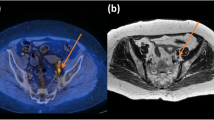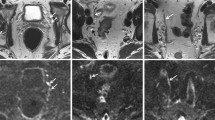Abstract
Objective
To investigate the usefulness of diffusion-weighted imaging (DWI) to discriminate between metastatic and non-metastatic small lymph nodes in pelvic carcinoma.
Materials and Methods
A total of 259 patients (180 normal, 79 metastatic) prospectively underwent DWI at 3 T. We measured the short-axis diameter and the mean apparent diffusion coefficient (ADC) value. Lymph nodes with a short-axis diameter larger than 8 mm were recorded as being suspected metastatic lymph nodes. Imaging data were correlated station by station with histopathological results.
Results
A total of 140 metastatic nodes were accurately matched with histology. On T2w, the short-axis diameter for non-metastatic and metastatic lymph nodes was 6.4 mm ± 2.5 mm and 8.3 mm ± 4.5 mm, respectively. Almost all metastatic or non-metastatic nodes had similar high signal intensity on DWI (except in 5 cases) with a homogeneous pattern. The mean ADC values (10−3 mm3/s ± standard deviation) of involved lymph nodes, control iliac nodes and control inguinal nodes were 924 ± 217, 968 ± 182 and 1,036 ± 181, respectively. There were no statistically significant differences in the ADC of metastatic and non-metastatic nodes.
Conclusion
Isolated measurement of mean ADC values in a suspected station does not contribute to the diagnosis of metastatic nodes, in patients with small ambiguous nodes.




Similar content being viewed by others
References
Choi HJ, Kim SH, Seo SS et al (2006) MRI for pretreatment lymph node staging in uterine cervical cancer. AJR Am J Roentgenol 187:W538–W543
Harisinghani MG, Barentsz J, Hahn PF et al (2003) Noninvasive detection of clinically occult lymph-node metastases in prostate cancer. N Engl J Med 348:2491–2499
Kim JH, Beets GL, Kim MJ et al (2004) High-resolution MR imaging for nodal staging in rectal cancer: are there any criteria in addition to the size? Eur J Radiol 52:78–83
Lin G, Ho KC, Wang JJ et al (2008) Detection of lymph node metastasis in cervical and uterine cancers by diffusion-weighted magnetic resonance imaging at 3T. J Magn Reson Imaging 28:128–135
Sumi M, Cauteren MV, Nakamura T (2006) MR micro imaging of benign and malignant nodes in the neck. AJR Am J Roentgenol 186:749–757
Holzapfel K, Duetsch S, Fauser C, Eiber M (2008) Value of diffusion-weighted MR imaging in the differentiation between benign and malignant cervical lymph nodes. Eur Radiol. doi:10.1016/j.ejrad.2008.09.034
Razek A, Soliman NY, Elkharaway S, Tawfik A (2006) Role of diffusion-weighted MR imaging in cervical lymphadenopathy. Eur Radiol 16:1468–1477
Ichikawa T, Haradome H, Hachiya J et al (1999) Diffusion-weighted MR imaging with single-shot echo-planar imaging in the upper abdomen: preliminary clinical experience in 61 patients. Abdom Imaging 24:456–461
Ichikawa T, Erturk SM, Motosugi U et al (2006) High-b-value diffusion-weighted MRI in colorectal cancer. AJR Am J Roentgenol 187:181–184
Charles-Edwards EM, deSouza NM (2006) Diffusion-weighted magnetic resonance imaging and its application to cancer. Cancer Imaging 6:135–143
Koh DM, Collins DJ (2007) Diffusion-weighted MRI in the body: applications and challenges in oncology. AJR Am J Roentgenol 188:1622–1635
Nakai G, Matsuki M, Inada Y et al (2008) Detection and evaluation of pelvic lymph nodes in patients with gynecologic malignancies using body diffusion-weighted magnetic resonance imaging. J Comput Assist Tomogr 32:764–768
Nakai G, Matsuki M, Inada Y et al (2008) Feasibility of diffusion-weighted Imaging in the differentiation of metastatic from nonmetastatic lymph nodes: early experience. J Magn Reson Imaging 28:714–719
Yang WT, Lam WWW, Yu MY, Cheung TH, Metreweli C (2000) Comparison of dynamic helical CT and dynamic MR imaging in the evaluation of pelvic lymph nodes in cervical carcinoma. AJR Am J Roentgenol 175:759–766
Curtin HD, Ishwaran H, Mancuso AA, Dalley RW, Caudry DJ, McNeil BJ (1998) Comparison of CT and MR imaging in staging of neck metastasis. Radiology 207:123–130
Thoeny HC, Triantafyllou M Birkhaeuser FD, Froehlich JM, Tshering DW, Binser T, Fleischmann A, Vermathen P, Studer UE (2009) Combined ultrasmall superparamagnetic particles of iron oxide-enhanced and diffusion-weighted magnetic resonance imaging reliably detect pelvic lymph node metastases in normal- sized nodes of bladder and prostate cancer patients. Eur Urol 55:770–772
Lyng H, Haraldseth O, Rofstadt EK (2000) Measurement of cell density and necrotic fraction in human melanoma xenografts by diffusion weighted magnetic resonance imaging. Magn Reson Med 43:828–836
Koh DM, Scurr E, Collins DJ et al (2006) Colorectal hepatic metastases: quantitative measurements using single-shot echo-planar diffusion-weighted MR imaging. Eur Radiol 16:1898–1905
Wang J, Takashima S, Takayama F et al (2001) Head and neck lesions: characterization with diffusion-weighted echo-planar MR imaging. Radiology 220:621–630
Koyama T, Togashi K (2007) Functional MR imaging of the female pelvis. J Magn Reson Imaging 25:1101–1112
Akduman E I, Momtahen AJ, Balci NC, Mahajann N, Havlioglu N, Wolverson MK (2008) Comparison between malignant and benign abdominal lymph nodes on diffusion weighted imaging. Acad Radiol 15:641–646
Park SO, Kim JK, Kim KA, Park BW, Kim N, Cho G, Choi HJ, Cho KS (2009) Relative apparent diffusion coefficient: determination of reference site and validation of benefit for detecting metastatic lymph nodes in uterine cervical cancer. J Magn Reson Imaging 29:383–390
Choi EK, Kim JK, Choi HJ, Park SO, Park BW, Kim N, Kim JS, Im KC, Cho G, Cho KS (2009) Node-by-node correlation between MR and PET/CT in patients with uterine cervical cancer: diffusion-weighted imaging versus size-based criteria on T2WI. Eur Radiol 19:2024–2032
Author information
Authors and Affiliations
Corresponding author
Rights and permissions
About this article
Cite this article
Roy, C., Bierry, G., Matau, A. et al. Value of diffusion-weighted imaging to detect small malignant pelvic lymph nodes at 3 T. Eur Radiol 20, 1803–1811 (2010). https://doi.org/10.1007/s00330-010-1736-4
Received:
Revised:
Accepted:
Published:
Issue Date:
DOI: https://doi.org/10.1007/s00330-010-1736-4




